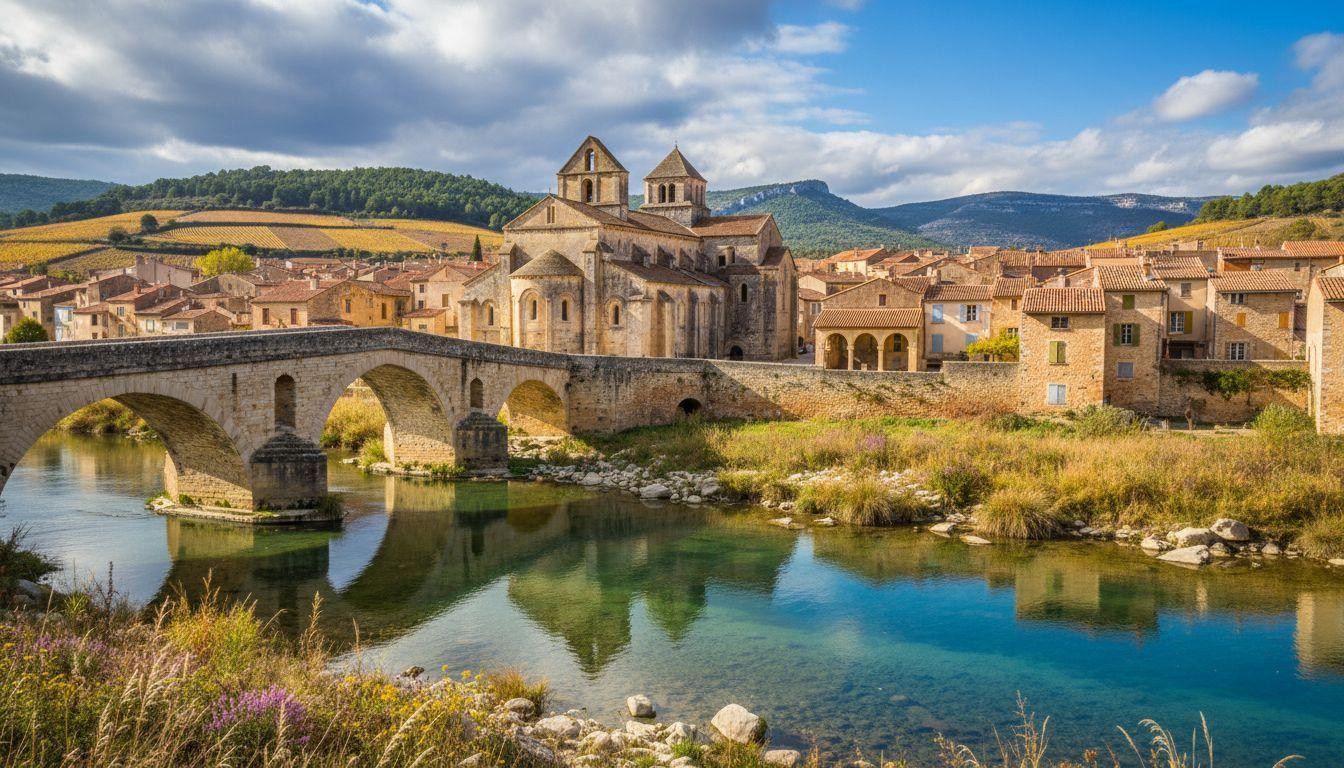Morning mist rises from the Orbieu River as church bells echo across golden stone walls that have witnessed 1,200 years of prayer. Lagrasse slumbers in southern France’s Aude valley, where an 8th-century Benedictine abbey anchors a medieval village of just 548 residents. While tour buses thunder toward Carcassonne 19 miles northeast, this overlooked sanctuary preserves monastic rhythms that Charlemagne himself once blessed.
Where Charlemagne’s abbey still breathes
The Abbey Sainte-Marie d’Orbieu emerges from morning shadows like a vision from 779 AD. Charlemagne’s founding charter still rests in Carcassonne’s departmental archives, documenting the moment this Benedictine monastery received royal protection. Unlike the tourist-packed ramparts of nearby Carcassonne, Lagrasse’s abbey continues its sacred purpose.
Since 2004, a community of canons regular has restored monastic life here. Their chanted prayers drift across courtyards where medieval scholars once copied manuscripts. The abbey operates in two sections: the active religious community occupies the original buildings, while the Aude Department has opened the historic cloister and Romanesque church for visitors since 2007.
Stone streets where time stands still
Beyond the 13th-century Pont Vieux bridge, cobblestone lanes wind through a village frozen in medieval amber. The 1315 covered market still shelters Saturday morning vendors selling honey and Corbières wine. Ancient ramparts embrace narrow streets where only 548 souls maintain traditions their ancestors knew seven centuries ago.
Architecture carved from local limestone
Golden Corbières stone glows warm against red clay tiles throughout the village center. The abbey’s Romanesque church showcases an 11th-century nave with three small apses, while 18th-century additions include a marble portal attributed to the Master of Cabestany. Restoration work continues revealing medieval treasures beneath later modifications.
The only Plus Beaux Village in Aude
Lagrasse earned France’s coveted “Plus Beaux Villages” designation as the sole representative from Aude department. Strict population limits and heritage requirements ensure authenticity: no chain stores disturb the medieval streetscape, no modern intrusions break the timeline. The fortress city of Carcassonne may draw millions, but Lagrasse attracts just 100,000 annual visitors who discover France’s authentic medieval spirit.
Living history beyond the guidebooks
November mornings reveal Lagrasse’s true character as locals gather at café terraces overlooking the river. The abbey opens its doors to curious travelers while maintaining daily prayers and meditation. Walking the rampart remnants requires no admission fee, no velvet ropes, no tourist crush.
Abbey visits that feel like pilgrimage
The cloister’s 18th-century galleries frame a garden where silence speaks louder than words. Visitors explore Romanesque architecture while canons regular continue 1,200 years of unbroken tradition. Entry costs just $11, a fraction of Carcassonne’s fortress fees. The medieval village of Cordes-sur-Ciel offers similar charm but lacks Lagrasse’s living monastic community.
Corbières wine country at your doorstep
Local vintners offer tastings in centuries-old cellars carved from limestone hillsides. November brings fresh olive oil from nearby groves, while village artisans craft pottery using techniques medieval monks perfected. The Saturday market transforms the 1315 covered hall into a feast of regional specialties: cassoulet beans, foie gras, and mountain honey.
November’s quiet revelations
Late autumn strips away summer crowds to reveal Lagrasse’s contemplative soul. Temperatures hover around 59°F, perfect for riverside walks where mist creates dramatic photographs. The wine villages of Minervois complete the harvest season, making November ideal for cellar visits and authentic local encounters.
Recent visitors describe the experience as stepping into a “ghost village where medieval life feels tangible.” Unlike Carcassonne’s theatrical reconstruction, Lagrasse never stopped being itself. The abbey bells still mark prayer times, villagers still gather at the ancient market, and the Orbieu still flows past walls that sheltered medieval pilgrims.
Your questions about Lagrasse’s medieval abbey answered
How does visiting cost compare to Carcassonne?
Abbey entry costs $11 versus Carcassonne’s $13 fortress admission. Village exploration remains free, unlike Carcassonne’s parking fees averaging $20 daily. Accommodations range from $70-$200 nightly in family-run guesthouses, significantly less than Carcassonne’s hotel chains. The hillside village of Minerve offers similar medieval charm with comparable pricing.
What makes the abbey experience unique?
Lagrasse maintains active monastic life alongside historical visits. Canons regular resumed residence in 2004, creating authentic spiritual atmosphere missing from purely touristic sites. The 11th-century Romanesque church still hosts daily prayers, while the Master of Cabestany’s marble sculptures remain in original context rather than museum cases.
Why visit in November instead of summer?
November eliminates summer crowds that can reach 300 daily visitors during peak season. Autumn light enhances golden limestone walls, while harvest season brings fresh local products to Saturday markets. The abbey’s contemplative atmosphere emerges fully when tourist buses head elsewhere.
River mist clears as afternoon light warms medieval stones and church bells call faithful souls to prayer. This is Lagrasse’s enduring magic: a place where sacred and secular merge naturally, where history lives rather than merely survives.
